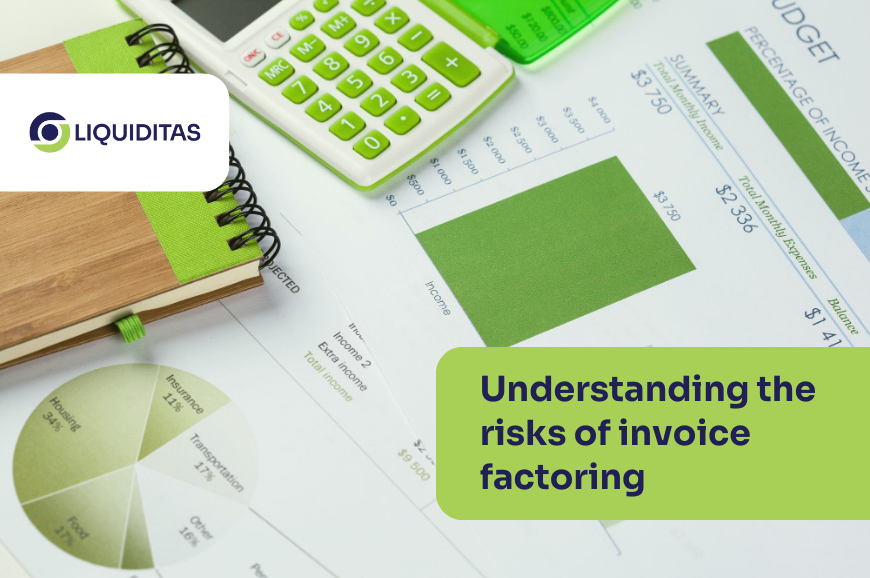
Having a deep understanding of the risks of invoice factoring is crucial for companies that are considering this financial option in order to alleviate the pressure of locked working capital.
Invoice factoring is a financial solution that has gained significant traction among businesses, especially small and medium enterprises (SMEs), seeking to optimise cash flow and manage working capital efficiently. In essence, it involves a transaction where a company sells its accounts receivable (invoices) to a third-party financial institution, known as a factor, at a discounted rate in exchange for immediate cash.
The surge in popularity of invoice factoring can be attributed to its ability to offer immediate liquidity to businesses facing cash flow challenges. This method provides an immediate infusion of funds by converting unpaid invoices into readily available capital. For businesses experiencing delayed payments or needing funds for expansion, operations, or fulfilling immediate financial obligations, invoice factoring serves as an invaluable solution.
The process of invoice factoring
The process of invoice factoring is straightforward yet impactful. Once a business delivers goods or services to its customers and issues an invoice with payment terms (typically 30, 60, or 90 days), it can opt to sell these invoices to a factor. The factor assesses the creditworthiness of the invoiced customers rather than the business itself. Upon approval, the factor advances a certain percentage of the invoice value (usually around 70-90%) to the business upfront, retaining the remaining amount as a reserve.
When the customer pays the invoice within the specified period, the factor releases the reserve amount to the business, deducting a small fee for their services. This fee typically ranges from 1-5% and may vary based on factors such as the invoice volume, creditworthiness of customers, and the duration until payment. However, if the customer fails to pay within the agreed period, the factor may take measures to collect the outstanding amount directly from the customer.
Overall, invoice factoring emerges as a flexible and efficient financial tool, enabling businesses to unlock the value of their accounts receivable, improve cash flow, and sustain operations without taking on additional debt. Its growing appeal stems from its ability to provide immediate access to cash, aiding businesses in navigating the complexities of cash flow management in today’s competitive market landscape.
As every instrument out there, invoice factoring has its own perks and downfalls, which can surely open the way for careful consideration before a certain business steps up in this game. Therefore let’s find out what are the benefits, as well as the risks of invoice factoring.
Benefits of invoice factoring
Invoice factoring offers businesses a broad spectrum of benefits, from improved cash flow and immediate access to working capital to the outsourcing of credit control and reduced risks associated with late payments. But what are the most eye-catching benefits that this tool offers to businesses?
Quick access to cash flow
Invoice factoring stands as a transformative financial strategy offering multifaceted benefits to businesses, epitomised by its ability to provide quick access to cash flow. This immediate liquidity infusion is a cornerstone advantage, particularly for SMEs encountering cash flow constraints. By swiftly converting accounts receivable into usable capital, businesses gain agility in meeting operational expenses, purchasing inventory, funding expansions, or seising growth opportunities without being hampered by delayed payments.
Improvement in working capital
The utilisation of invoice factoring leads to a pronounced enhancement in working capital management. This financial tool empowers businesses to optimise their cash flow cycles by converting unpaid invoices into immediate funds. By accelerating the collection of outstanding receivables, companies bolster their cash reserves, enabling more robust financial maneuverability and strategic decision-making. The improved working capital further fortifies a business’s ability to negotiate better terms with suppliers, capitalise on early payment discounts, and ultimately foster sustained growth.
Outsourcing credit and collection tasks
One of the understated yet impactful benefits of invoice factoring is the ability to outsource credit and collection tasks to the factor. This shift in responsibility liberates businesses from the intricacies and administrative burdens associated with chasing overdue payments. Factors, equipped with specialised expertise and resources, assume the role of monitoring and collecting payments from customers. This outsourcing of credit and collection tasks not only alleviates the administrative burden on businesses but also mitigates the risks associated with bad debts. It allows companies to redirect their focus towards core operations and strategic initiatives, thereby enhancing productivity and efficiency.
In essence, invoice factoring’s triumvirate of advantages—swift access to cash flow, bolstered working capital, and the outsourcing of credit and collection tasks—constitutes a compelling proposition for businesses seeking to optimise their financial operations. By reducing working capital and relieving companies of the burden of handling receivables, this financial instrument not only helps with short-term cash flow issues but also promotes long-term financial stability, enabling them to prosper in the cutthroat business environment of today.
Risks associated with invoice factoring
There are three types of risks that are associated with invoice factoring: financial, relationship and operational risks. Below is a short brief for each type of risk and its constituent elements.
Financial risks
Cost of factoring fees
Invoice factoring typically incurs fees, which can vary based on the provider and terms. These fees can directly impact the overall cost of financing, potentially reducing the net revenue a business receives from its invoices.
Impact on profit margins
Factoring fees and associated costs can eat into profit margins, affecting the overall profitability of the business. Depending on the fee structure, this reduction in margins might be significant, affecting the financial health of the company.
Long-term expenses
While factoring offers immediate cash flow, relying on it extensively in the long term might mean consistently paying fees, which can accumulate as a significant expense over time, impacting the financial sustainability of the business.
Relationship risks
Potential damage to customer relationships
Using a factoring company might lead to changes in the way customers interact with a business. If not managed carefully, customers might perceive the business differently or feel uncomfortable dealing with a third party in payment matters, potentially straining relationships.
Loss of control over collections
When a business factors its invoices, it relinquishes control over collections to the factoring company. This could affect the relationship dynamic with customers, as well as the ability to customise payment plans or negotiate terms directly.
Operational risks
Impact on business reputation
If a factoring company employs aggressive collection tactics or if there are misunderstandings about the business’s financial health due to factoring, it could negatively impact the company’s reputation, potentially affecting its ability to attract customers or partners.
Difficulty in scaling with a factoring company’s limits
Businesses might face limitations on scaling if the factoring company sets caps on the total amount or number of invoices they’re willing to factor in. This could impede growth plans or cause operational disruptions if the business exceeds these limits.
Supply chain finance or invoice factoring
Supply chain finance solutions and invoice factoring serve distinct purposes within the realm of managing cash flow for businesses. The choice between the two depends on various factors, including the specific needs of the business, relationships with suppliers, and the desired level of control and cost-effectiveness.
- Supply chain finance solutions, such as early payment programs or dynamic discounting, are geared towards optimising the cash flow between buyers and suppliers. These solutions enable buyers to extend their payment terms while allowing suppliers to get paid earlier at a discounted rate. This benefits both parties by enhancing cash flow without involving third-party financiers. Supply chain finance solutions tend to foster stronger relationships between buyers and suppliers, as they maintain the direct connection between them and often come with lower fees compared to invoice factoring.
- Invoice factoring, on the other hand, involves selling accounts receivable to a third party at a discount in exchange for immediate cash. This can be a quick way to improve liquidity, but it typically comes with higher fees compared to supply chain finance solutions. Therefore, invoice factoring might come with slightly bigger risks. Factoring companies might directly interact with the business’s customers for payment, potentially impacting relationships and the business’s reputation. Moreover, invoice factoring might not offer the same level of control and flexibility as supply chain finance solutions since it involves selling batches of invoices rather than selectively choosing which invoices to pay early.
Conclusion
When deciding between supply chain finance solutions and invoice factoring, businesses should consider their specific needs and priorities. Supply chain finance solutions are often favoured for their ability to maintain control, preserve relationships, and offer flexibility in managing cash flow without incurring high fees. Invoice factoring might be chosen for its quick access to cash, although it typically involves higher costs and potential disruptions to customer relationships.
In conclusion, while both supply chain finance solutions and invoice factoring provide means to manage cash flow, supply chain finance solutions are generally perceived as a better option for businesses looking to optimise their working capital, maintain control over customer relationships, and minimise costs associated with external financing. However, the choice ultimately depends on the specific circumstances and priorities of the business in question.

